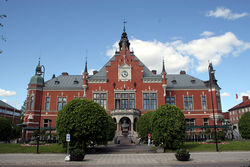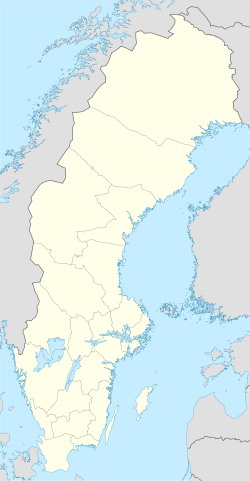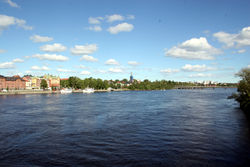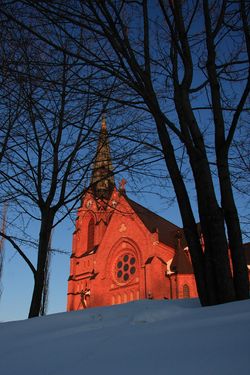Umeå
| Umeå | |
|---|---|
 |
|
| Nickname(s): Björkarnas Stad (The city of birches) | |
 Umeå
|
|
| Coordinates: | |
| Country | Sweden |
| Province | Västerbotten |
| County | Västerbotten County |
| Municipality | Umeå Municipality |
| Charter | 17th Century |
| Area[1] | |
| - Total | 33.46 km2 (12.9 sq mi) |
| Population (2010-01-31)[1] | |
| - Total | 75,645 |
| - Density | 2,261/km2 (5,856/sq mi) |
| Time zone | CET (UTC+1) |
| - Summer (DST) | CEST (UTC+2) |
| Website | www.umea.se |
Umeå (Swedish pronunciation: [ʉːmе.оː] (![]() listen); Finnish: Uumaja, Northern Sami: Ubmi) is a university town in Västerbotten, Sweden.
listen); Finnish: Uumaja, Northern Sami: Ubmi) is a university town in Västerbotten, Sweden.
Umeå is the biggest city in Norrland, the capital of Västerbotten County and the seat of Umeå Municipality. The city proper has 75,000 inhabitants (2005) out of a municipal total of 114,075 (2009).[2]
Umeå is a center of education, technical and medical research in Sweden, with two universities and over 30,000 students. The city is elected European Capital of Culture of 2014.
Umeå has been expanding for several decades and is one of Sweden's fastest growing cities. Growth sped up in 1965, when the university was established. In the last 30 years, housing in Umeå has doubled and this rate of growth continues. As of 2008[update], 700 to 800 new apartments are constructed each year.[3]
Contents |
History
The first written mention of Umeå is from the 14th century. The northern parts of Sweden, including the counties of Västerbotten and Norrbotten, were settled by Sami people before this time, though not necessarily in the city's exact location. Umeå in its first form was a parish with a wooden church and trade post located in the section of town now known as Backen (or Kyrkbacken). Its location near the coast and on a river was probably one of the reasons that people chose to settle there.[4]
For the next couple of centuries Umeå was a place consisting of scattered parishes, where merchandise originating with the Sami people was traded, and was the last inhabited place before the northern wilderness took over. However, no real city was built at the location selected by the king, and it lost its town privileges in the 1590s.[4]
In 1622, a city was again founded by King Gustav II Adolf [5] In 1638, it had about 40 houses.[4] It suffered from Russian attacks in 1714 and in 1720 when it was burnt to the ground. At the close of the Finnish War in 1809 the Russian army under Barclay de Tolly took Umeå and held it from June to August.[6]
On 25 June 1888, a fire devastated the eastern parts of Umeå and at least 2,300 of the 3,000 inhabitants became homeless. In the restoration following the fire, silver birch trees were planted along wide avenues to prevent future fires from spreading.[7] For this reason Umeå is sometimes known as "Björkarnas Stad", the "City of Birches" or "Little Stockholm"[8] and the Umeå ice-hockey team, Björklöven, means "The Birch Leaves".
Geography
Umeå is situated on the inlet of the Gulf of Bothnia at the mouth of the Ume River, in the south of Västerbotten. Umeå is about 600 km north of Stockholm at and about 400 km south of the Arctic Circle. It is the largest city north of the Stockholm-Uppsala region, and is sometimes referred to as the regional centre of northern Sweden. The nearby community of Holmsund serves as its port. From here a ferry line connects it with the neighbouring city of Vaasa (Swedish: Vasa) in Finland. The near connections to Finland effects the population of the city - several Sweden Finns live in Umeå.
| Climate data for Umeå | |||||||||||||
|---|---|---|---|---|---|---|---|---|---|---|---|---|---|
| Month | Jan | Feb | Mar | Apr | May | Jun | Jul | Aug | Sep | Oct | Nov | Dec | Year |
| Average high °C (°F) | -5 (23) |
-4 (25) |
0 (32) |
6 (43) |
12 (54) |
17 (63) |
20 (68) |
18 (64) |
13 (55) |
7 (45) |
0 (32) |
-4 (25) |
6.7 (44.1) |
| Average low °C (°F) | -11 (12) |
-11 (12) |
-8 (18) |
-3 (27) |
2 (36) |
8 (46) |
11 (52) |
10 (50) |
5 (41) |
1 (34) |
-4 (25) |
-9 (16) |
-0.8 (30.6) |
| Source: MSN Weather[9] | |||||||||||||
Transport
The road infrastructure in Umeå is well-developed, with two European highways (E4 and E12) passing through the city.[10] About 7 km from the city centre (4 km) is the Umeå City Airport.[11] It is the 7th largest airport in Sweden by annual number of passengers, with 815,154 passengers in 2009.
The railway infrastructure is not currently as well developed as the roads. The only rail connection to the rest of the country is an inland line, on which it takes approximately 10 hours by night train to reach Stockholm. However, Umeå is part of the biggest railway construction project in Sweden, the Bothnia Line (or Botniabanan), which is currently being constructed from Sundsvall along the High Coast via Örnsköldsvik to Umeå. This new railway line will be 190 km long, with 140 bridges and 25 km of tunnels. The Bothnia Line will be able to cope with speeds of up to 250 km/hour, and will give Umeå a fast train connection to Stockholm (5½ hours) and the rest of Europe.
Culture
Umeå has become a capital of culture in northern Sweden. The Opera of northern Sweden, the Norrland Opera, is based in the city. The annual Umeå Jazz Festival is one of the larger Scandinavian festivals for modern jazz. Umeå is the home of the heavy metal band Meshuggah, which was labelled by the Rolling Stone as "one of the ten most important hard and heavy bands";[12] as well as Cult of Luna. Umeå is also where hardcore punk band Refused originated. House of Metal is a metal festival in Umeå which has grown quite big. Over well-known metal bands from Umeå include Nocturnal Rites and Persuader.
The main museums in Umeå are: Museum of the county of Västerbotten,the museum of Umeå, The Museum of Visual Culture and the Museum of Skiing.
Umeå is a centre for cultural activities, with annual film and music festivals. At the moment the world's northmost mosque is about to be built in the eastern parts of Umeå. The city has been elected the European Cultural Capital for 2014.[13]
Umeå is the center of television in northern Sweden, SVT Nord and TV4's northern region office are both based in the city. The main newspapers of the county of Västerbotten, Västerbottens-Kuriren and Västerbottens Folkblad are also based in Umeå.



A 1996 study of over 67,000 Swedish students between the ages of 16 and 20 found that there is a particularly high concentration of vegans in Umeå. 3.3% of the students in Umeå were vegan, three to four times as many as are found in other cities in Sweden.[14][15]
Sports
The city of Umeå currently hosts two well-known sports teams. The women's soccer team Umeå IK was the top ranked ladies club soccer team in the world in 2008. The men's hockey team Björklöven was very successful in the 1980s but has been less successful in recent years. Björklöven are currently playing in the Swedish second-tier league Allsvenskan while Umeå IK plays in the top Swedish women's football league Damallsvenskan.
Education and research
Umeå University has about 29,000 students and 4,200 staff. The establishment of the university in the mid 1960s led to a population expansion from about 50,000 inhabitants to today's 110,750. The expansion continues, with about 1000 new inhabitants every year, and has made Umeå a modern, somewhat intellectual city in contrast to the traditional basis on heavy industry for cities along the coast of northern Sweden (Norrland).
The Swedish University of Agricultural Sciences or Sveriges Lantbruksuniversitet is a university in Sweden. Although its head office is located in Ultuna, Uppsala, the university has several campuses in different parts of Sweden, the other main facilities being Umeå. Unlike other state owned universities in Sweden, it is funded through the budget for the Ministry of Agriculture.
The university hospital serves the entire region of northern Sweden.
Economy
Key research fields of the University are life sciences (especially medical and cell and the molecular biology of plants), human technology interaction, social welfare, ecology and gender perspectives.
The Umeå University works collaboratively with companies such as ABB, Volvo, Skanska, Ericsson, and Ohrlings PricewaterhouseCoopers.
The Swedish University of Agricultural Sciences (SLU) in Umeå, with Umeå Plant Science Center, is another major site of research and education.
Notable companies based in Umeå:
- Komatsu Forest, European HQ
- Siemens Financial Services, Scandinavian HQ
- Volvo Lastvagnar
- AstraZeneca (production unit, to be closed summer of 2011)[16]
- Handelsbanken, HQ in the northern region of Sweden
- ÅLÖ
Famous people
- Ibrahim Baylan, politician
- Linda Bergkvist, artist
- Kjell-Olof Feldt, politician
- Sara Lidman, novelist
- Stig Lindberg, artist
- Jonas Sjöstedt, politician
- Stieg Larsson, novelist
Athletes
- Björn Berg
- Jesper Blomqvist
- Jörgen Brink
- Per Elofsson
- Hanna Ljungberg
- Gunnar Nordahl
- Anja Pärson
- Assar Rönnlund
- Daniel Tjärnqvist
Bands and musicians
- Amandine band
- Cult of Luna band
- Komeda band
- Meshuggah band
- Naglfar (band)
- Nocturnal Rites band
- The Perishers (band)
- Persuader band
- Refused band
- The (International) Noise Conspiracy band
- DS-13 band
- Zonaria band
- Eva Dahlgren
- Johan Edlund
- Frida Hyvönen
- Daniel Lindström
- Dennis Lyxzén
- Lisa Miskovsky
- Nicklas Nygren
- David Sandström
- Mats Öberg
- Morgan Ågren
- Brian Burns
- Mats Gustafsson saxophone player
See also
- NorrlandsOperan
- Battle of Ratan and Sävar
- Umeå Hardcore
- Umeå Open
- Bridge between Umeå and Vaasa
References
- ↑ 1.0 1.1 "Tätorternas landareal, folkmängd och invånare per km2 2000 och 2005" (in Swedish) (xls). Statistics Sweden. http://www.scb.se/statistik/MI/MI0810/2005A01B/T%c3%a4torternami0810tab1.xls. Retrieved 2009-05-09.
- ↑ Statistics Sweden
- ↑ More about Umeå - Umeå kommun
- ↑ 4.0 4.1 4.2 (Swedish) 1300-1652 Umeå kommun - Umeå official website. Retrieved August 26, 2008
- ↑ living in Umeå - International Office
- ↑ (Swedish) 1714-1809 - Umeå kommun - Umeå official website. Retrieved August 26, 2008
- ↑ Did you know that...? - Umeå University
- ↑ http://www.umearegionen.se/download/18.5df2398c11695225c37800073434/eng.pdf
- ↑ "Weather Information for Umeå". MSN Weather. http://weather.msn.com/local.aspx?wealocations=wc:SWXX0038&q=Ume%c3%a5%2c+SWE. Retrieved 1 January 2009.
- ↑ Sweden Tourism. Map of Sweden. Accessed 2010-04-14.
- ↑ Google Maps. Umeå. Accessed 2010-04-14.
- ↑ "Meshuggah". Nuclear Blast. http://www.nuclearblastusa.com/bands/meshuggah.html. Retrieved 2008-06-10.
- ↑ Umeå 2014 - Umeå - Capital of Culture 2014
- ↑ Larsson, Christel (2001). Young vegetarians and omnivores. Dietary habits and other health-related aspects. Umeå, Sweden: Umeå University. p. 40. ISBN 91-7191-983-X. http://www3.umu.se/KOST/forskning/fulltextCL.pdf. Retrieved 2009-08-27. "
"Country, city Study design Yeara Age(years) nb … Ve … Sweden (I)g Telephone interview with school matrons. 1996 16-20 67 370 … 0.1 … Sweden, Umeå (I)g Telephone interview with school matrons. 1996 16-20 3 450 … 2.1 … - ↑ Larsson, Christel; Klock K, Nordrehaug Åstrøm A, Haugejorden O, Johansson G (10 2001). "Food habits of young Swedish and Norwegian vegetarians and omnivores.". Public Health Nutrition 4 (5): 1005–14. PMID 11784414.
- ↑ Västerbottens-kuriren, http://www.vk.se/Article.jsp?article=260984, retrieved 2010-03-03
External links
- Umeå, official site
- Umeå Capital of Culture 2014, official site
- Umeå Region, official site
- Umeå Tourist Office, official site
| Umeå is one of 133 places with the historical city status in Sweden. |
|
|||||
|
||||||||||||||
|
|||||||||
|
|||||||||||||||||||||||||||||||||||||||||||||||||
|
|||||||||||||||||||||||||||||||||||||||||||||||||||||||||||||||||||||||||||||||||||||||||||||||||||||||